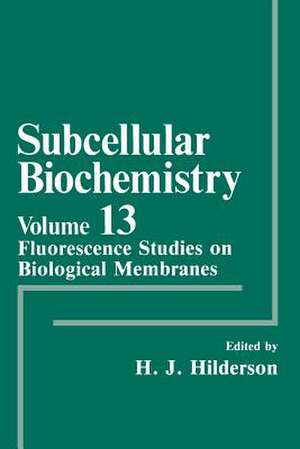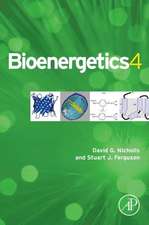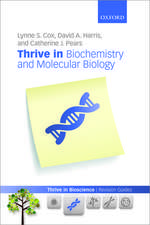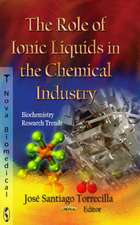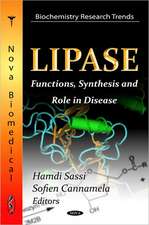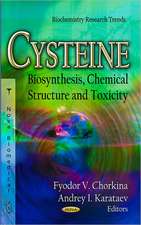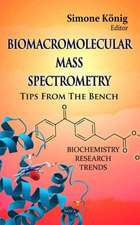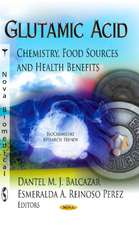Fluorescence Studies on Biological Membranes: Subcellular Biochemistry, cartea 13
Editat de Herwig J. Hildersonen Limba Engleză Paperback – 4 dec 2011
Din seria Subcellular Biochemistry
- 18%
 Preț: 948.79 lei
Preț: 948.79 lei - 5%
 Preț: 1456.88 lei
Preț: 1456.88 lei - 18%
 Preț: 1373.84 lei
Preț: 1373.84 lei - 18%
 Preț: 1243.78 lei
Preț: 1243.78 lei - 18%
 Preț: 2098.81 lei
Preț: 2098.81 lei - 18%
 Preț: 1122.10 lei
Preț: 1122.10 lei - 5%
 Preț: 1160.63 lei
Preț: 1160.63 lei - 18%
 Preț: 1396.26 lei
Preț: 1396.26 lei - 18%
 Preț: 1114.96 lei
Preț: 1114.96 lei - 18%
 Preț: 1224.68 lei
Preț: 1224.68 lei - 18%
 Preț: 951.29 lei
Preț: 951.29 lei - 18%
 Preț: 1227.99 lei
Preț: 1227.99 lei -
 Preț: 399.88 lei
Preț: 399.88 lei - 18%
 Preț: 1231.47 lei
Preț: 1231.47 lei - 18%
 Preț: 1230.35 lei
Preț: 1230.35 lei -
 Preț: 392.60 lei
Preț: 392.60 lei - 18%
 Preț: 1231.47 lei
Preț: 1231.47 lei - 15%
 Preț: 638.76 lei
Preț: 638.76 lei - 5%
 Preț: 656.26 lei
Preț: 656.26 lei -
 Preț: 389.49 lei
Preț: 389.49 lei - 5%
 Preț: 659.19 lei
Preț: 659.19 lei -
 Preț: 392.37 lei
Preț: 392.37 lei - 5%
 Preț: 662.09 lei
Preț: 662.09 lei -
 Preț: 395.09 lei
Preț: 395.09 lei - 5%
 Preț: 667.99 lei
Preț: 667.99 lei -
 Preț: 400.47 lei
Preț: 400.47 lei - 18%
 Preț: 1224.54 lei
Preț: 1224.54 lei - 15%
 Preț: 647.73 lei
Preț: 647.73 lei - 15%
 Preț: 646.75 lei
Preț: 646.75 lei - 5%
 Preț: 662.30 lei
Preț: 662.30 lei -
 Preț: 395.25 lei
Preț: 395.25 lei - 18%
 Preț: 1230.21 lei
Preț: 1230.21 lei - 18%
 Preț: 1231.95 lei
Preț: 1231.95 lei - 18%
 Preț: 964.54 lei
Preț: 964.54 lei
Preț: 398.15 lei
Nou
Puncte Express: 597
Preț estimativ în valută:
76.19€ • 82.74$ • 64.00£
76.19€ • 82.74$ • 64.00£
Carte tipărită la comandă
Livrare economică 22 aprilie-06 mai
Preluare comenzi: 021 569.72.76
Specificații
ISBN-13: 9781461393610
ISBN-10: 1461393612
Pagini: 492
Ilustrații: 465 p.
Dimensiuni: 152 x 229 x 26 mm
Greutate: 0.65 kg
Ediția:Softcover reprint of the original 1st ed. 1988
Editura: Springer Us
Colecția Springer
Seria Subcellular Biochemistry
Locul publicării:New York, NY, United States
ISBN-10: 1461393612
Pagini: 492
Ilustrații: 465 p.
Dimensiuni: 152 x 229 x 26 mm
Greutate: 0.65 kg
Ediția:Softcover reprint of the original 1st ed. 1988
Editura: Springer Us
Colecția Springer
Seria Subcellular Biochemistry
Locul publicării:New York, NY, United States
Public țintă
ResearchCuprins
1 Biomembrane Structure and Dynamics Viewed by Fluorescence.- 1. Introduction to Fluorescence.- 2. Dynamics and Structure of Membranes.- 3. Fluorescence Techniques and What They Make Visible.- 4. Summary and Conclusions.- 5. References.- 2 Dynamic Structure of Membranes and Subcellular Components Revealed by Optical Anisotropy Decay Methods.- 1. Introduction.- 2. Optical Anisotropy Decay.- 3. Examples of Application.- 4. Concluding Remarks.- 5. References.- 3 Principles of Frequency-Domain Fluorescence Spectroscopy and Applications to Cell Membranes.- 1. Introduction.- 2. Comparison of Time- and Frequency-Domain Measurements.- 3. Theory of Frequency-Domain Fluorometry.- 4. Intensity Decays of DPH-Labeled Membranes.- 5. Anisotropy Decays of Labeled Membranes.- 6. Time-Resolved Emission Spectra.- 7. Energy Transfer in Membranes.- 8. A 2-GHz Frequency-Domain Fluorometer.- 9. Future Developments.- 10. Summary.- 11. References.- 4 Time-Resolved Fluorescence Depolarization Techniques in Model Membrane Systems: Effect of Sterols and Unsaturations.- 1. Introduction.- 2. Intrinsic Motional Properties of Some Widely Used Fluorescent Probes.- 3. Sterol-Phospholipid Interactions in Model Membranes.- 4. Concluding Remarks.- 5. References.- 5 Fluorescence Polarization to Evaluate the Fluidity of Natural and Reconstituted Membranes.- 1. Introduction.- 2. Methodology.- 3. Current Advancements in the Measurement of Ion-Membrane Interactions Using Fluorescence Polarization.- 4. Critical Evaluation of the Significance of Ion-Membrane Measurements.- 5. Concluding Remarks.- 6. References.- 6 Fluidity of Thyroid Plasma Membranes.- 1. Introduction.- 2. Thyroid Plasma Membranes.- 3. Fluidity of Thyroid Plasma Membranes.- 4. Modulation of the Adenylate Cyclase Activity by Manipulating the Plasma Membrane Composition.- 5. Involvement of Membrane Fluidity on Human Normal and Pathological Thyroid Glands.- 6. References.- 7 Spectroscopic Analysis of the Structure of Bacteriorhodopsin.- 1. Introduction.- 2. Principle of the Fluorescence Energy Transfer Technique.- 3. Three-Dimensional Disposition of the Retinal Chromophore in the Purple Membrane.- 4. In-Plane Location of NBD (7-Chloro-4-Nitrobenzo-2-Oxa-l,3-Diazole) Bound to Lys-41 in the Purple Membrane.- 5. Conformational Prediction of Bacteriorhodopsin Molecule.- 6. References.- 8 Structure and Dynamics of the Liver Microsomal Monoxygenase System.- 1. Introduction.- 2. Membrane Dynamics and Order Studied by Fluorescence.- 3. References.- 9 Fluorescence Studies on Prokaryotic Membranes.- 1. Introduction.- 2. Fluorescent Probes.- 3. Structural Aspects of Bacterial Membranes.- 4. Periplasm.- 5. Incorporation of Exogenous Lipids into Prokaryotic Membranes.- 6. Concluding Remarks.- 7. References.- 10 The Study of Cytoskeletal Protein Interactions by Fluorescence Probe Techniques.- 1. Introduction.- 2. The Cytoskeleton.- 3. Fluorescence Probe Techniques.- 4. Alternative Luminescence Techniques.- 5. Summary and Future Prospects.- 6. References.- 11 Fluorescent Probes for the Acetylcholine Receptor Surface Environments.- 1. Introduction.- 2. An Overview of AchR Properties.- 3. PTSA: A Probe for Measuring AchR-Mediated Ionic Fluxes in the Physiological Time Scale.- 4. Pyrene-1-Sulfonyl Azide (PySA): A Probe for the Study of the AchR-Lipid Interface.- 5. Pyrene Maleimide (PM): The Labeling of a Functionally Relevant Sulfhydryl Group.- 6. State and Organization of the Lipid Bilayer in AchR Membranes.- 7. Summary.- 8. References.- 12 Structural Basis and Physiological Control of Membrane Fluidity in Normal and Tumor Cells.- 1. Introduction.- 2. Quantitative Contribution of Individual Types of Lipid to Membrane Fluidity.- 3. Alterations in Membrane Fluidity in Lymphoid Tumor Cells.- 4. Effects of Dietary Lipids on Membrane Fluidity.- 5. References.- 13 Fusion of Enveloped Viruses with Biological Membranes: Fluorescence Dequenching Studies.- 1. Introduction.- 2. Receptors for Enveloped Viruses.- 3. Interaction of Enveloped Viruses with Receptor-Depleted Cells.- 4. Theoretical Aspects of the Use of Fluorescence Dequenching to Measure Viral Fusion.- 5. Fusion of Enveloped Viruses with Animal Cells and Biological Membranes: Studies with Intact Virions.- 6. Use of Fluorescent Dequenching Methods to Study Fusion of Enveloped Viruses with Biological Membranes Lacking Virus Receptors.- 7. Role of Viral Glycoproteins in the Process of Virus Membrane Fusion: Studies with Reconstituted Viral Envelopes.- 8. Fusion of Enveloped Viruses with Negatively Charged and Neutral Liposomes.- 9. Role of Conformational Changes and Cooperativity of Viral Proteins in Mediating Membrane Fusion.- 10. Conclusions.- 11. References.
